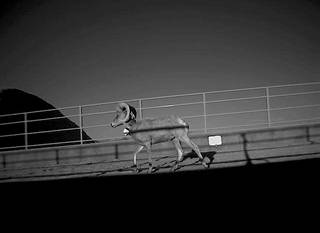
Courtesy AGFD
A team from the National Park Service attempts to capture a ram for tagging purposes. The NPS tagged animals to track data about the desert big horn sheep’s movements, data that led to the construction of three wildlife bypasses over US-93 in Arizona.
Monday, Feb. 21, 2011 | 2:05 a.m.
Sun archives
- When bypass opens, bighorn sheep could be a big problem (10-5-2009)
- State relocates sheep from River Mountains (11-10-2008)
- Bighorns find summer home in Boulder City (7-29-2005)
- Sheep horning in on Boulder City’s highway bypass plans (11-12-2004)
- Bighorn sheep concerns may add to cost of building bypass (8-25-2004)
Desert bighorn sheep are finding safe passage over U.S. 93 in Arizona thanks to three wildlife bypasses that opened in January, part of an effort by the Arizona Game and Fish Department to protect the animals and drivers.
Last week, the department recorded some of the first rams to use the bypasses and shared the photographs with the Sun.
With the opening of the Hoover Dam bypass bridge in October, thousands of commercial trucks and passenger vehicles have been pouring into Nevada via U.S. 93 for the first time in almost 10 years.
Before traffic was rerouted amid concerns about terrorism after Sept. 11, 2001, that stretch of road saw 10 or more collisions a year between the sheep and vehicles, said Jeff Gagnon, a research biologist with the AGFD. Most occurred within 20 miles of Hoover Dam.
Those numbers dwindled when truck traffic was banned from U.S. 93 and bridge construction began, but Gagnon said the department estimated collisions would eclipse pre-construction levels when the bypass bridge opened.
The bridge is expected to attract more traffic, and U.S. 93 has been expanded to four lanes in Arizona, said Zen Mocarski, a spokesman for the AGFD.
The National Park Service and AGFD conducted a study of the animals’ movement before constructing the wildlife bypasses, which cost just under $2 million each and were funded by state and federal grants.
About 75 animals were captured, tagged and released so researchers could observe their travel habits. Using that data, officials chose mile markers 3.3, 5.2 and 12.2 as the best spots for the crossings.
In addition to ensuring human safety, the crossings will help maintain a healthy desert bighorn population, Mocarski said. The animals are not listed as endangered, but the situation is still precarious, he said. Males mate with many females, so if one ram is killed, the impact is felt for generations.
A final bit of fencing was installed in January, which will funnel the sheep to the crossings, Mocarski said. He said he hopes if the bypasses prove useful, other areas with similar problems will take notice.
“I don’t want to get ahead of the game, but this is a significant marker of the project’s potential for success,” he said. “Seeing those pictures really got me excited. It’s a great first step.”


Join the Discussion:
Check this out for a full explanation of our conversion to the LiveFyre commenting system and instructions on how to sign up for an account.
Full comments policy